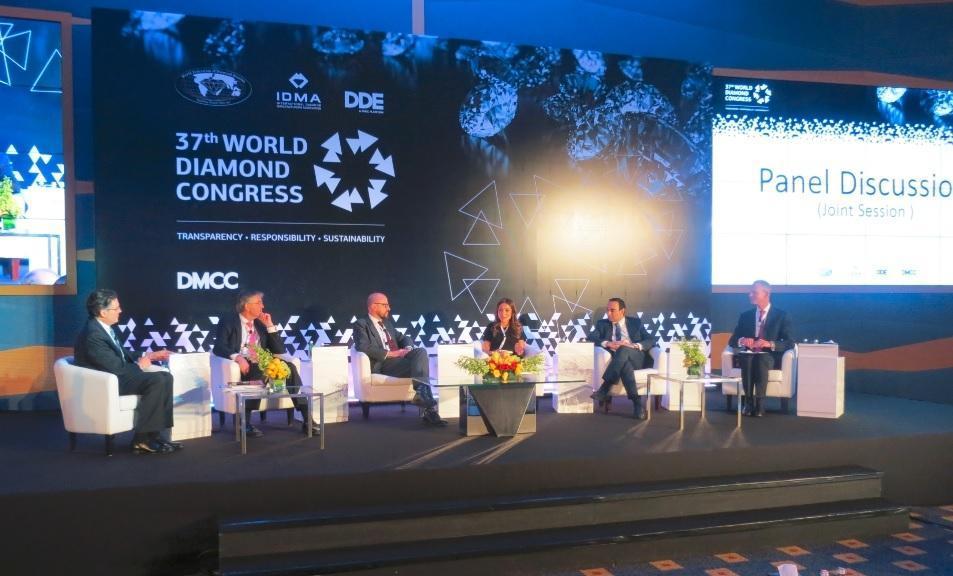According to Avi Krawitz at diamonds.net, the diamond industry is waking up to a new reality. Not only are the banks insisting on stricter compliance standards and pipeline integrity, but the largest mining companies and jewelry retailers are rapidly following suit.
This is forcing the industry to rethink the way it conducts business so that ‘transparency, responsibility and sustainability’ are engrained in the ethos of the trade.
It was therefore no coincidence those three concepts formed the central theme of the World Diamond Congress recently held in Dubai. “These themes run through all the challenges we’re facing as a global industry and also show us the way forward,” Ernie Blom, president of the World Federation of Diamond Bourses (WFDB), said in his opening remarks at the congress, a joint meeting of the WFDB and the International Diamond Manufacturers Association (IDMA).
The theme formed the backdrop to dealing with the stark dilemmas facing the sector, such as the lack of manufacturing profit, the threat posed by synthetic diamonds, changing consumer trends, marketing diamonds to millennials and changing the high-risk perceptions banks have about the industry.
But, from the industry’s perspective, what impact is this pursuit of transparency, responsibility and sustainability having?
Well, De Beers now requires clients to demonstrate transparency by presenting a consolidated corporate structure, proper bookkeeping, transactions they’re able to vouch for, and by adhering to third-party scrutiny, according to Howard Davies, head of corporate development at the diamond miner. Sustainability, meanwhile, encompasses maintaining a profitable business model and a strong equity base. “The combination of transparency and sustainability leads to bankability,” Davies stressed. “To gain the trust of the banks, you can’t have one without the other.”
For that reason, De Beers is insisting clients meet international financial reporting standards (IFRS) and its best practice principles to gain sightholder status. Doing so contributes to de-risking the industry, particularly in the eyes of the banks who themselves are being held to higher compliance standards, Davies said.
With Basel IV regulations now in the works, bankers at the congress acknowledged their fastest growing department is the compliance division, responsible for ensuring clients meet the standards required of them. And they’re particularly aware of the unique challenges facing their clients operating in the diamond industry.
Years of informal business practice, closing transactions with a simple handshake and proclaiming “mazal u’vracha,” have led the industry to fall short of banks’ expectations in the current regulatory environment. A string of major defaults, along with claims diamonds are used to fuel conflict or human rights violations, finance terror, and for money laundering purposes, have enhanced the sector’s “high risk” status.
Such reputational vulnerabilities led to a strong call for the trade to exert greater responsibility in how and with whom it does business. This saw the WFDB endorse the ‘know-your-client’ (KYC) initiative of India’s Gem and Jewellery Export Promotion Council in an attempt to more widely establish KYC standards across the industry. “KYC will enable diamond firms and other entities to receive important information about their customers or suppliers to confirm their authenticity and that of their transactions,” Blom explained. “This is critical because all banks follow a KYC process.”
Indeed, as the industry rethinks how it engages with consumers, the congress recognized the sector has to change its message to reflect the “different values” millennials hold. In the same way the synthetic diamond industry is competing by appealing to the “environmentally friendly, ethical and socially conscious” consumer, so too the natural diamond trade needs to prove it holds those - and higher - values.
That message is vital as the industry tries to recapture the imagination of consumers and consequently enable a sustainably profitable trade. More than that, the diamond industry simply cannot maintain its old “traditional” way of doing business. As Blom concluded, “we must take up the challenge of updating our ways of operating.”
The 2016 World Diamond Congress acknowledged that transparency, responsibility and sustainability are not just goals to work toward, they’re absolutely essential for the industry’s survival. That’s just the reality of today’s consumer and regulatory environment.
Originally published on diamonds.net this article by Avi Krawitz summarizes the important discussions that took place 2016 World Diamond Conference. Read the entire article here.



